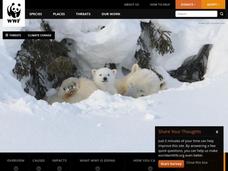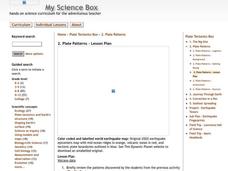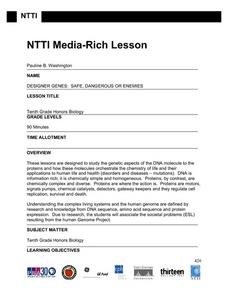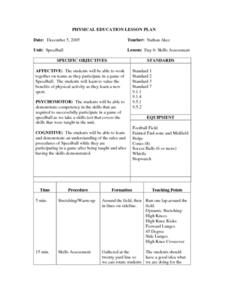Curated OER
Specialized for the Sea
Students use pictures and make a mural to investigate how ocean animals are adapted to certain parts of their environment.
Curated OER
Gelatin Volcanoes
Students investigate magma flow using gelatin volcano models. In this earth science lesson, students sketch the magma bodies as observed from the top of their model. They explain why magma moves that way.
Curated OER
Striking - Toss and Hit
Help your young athletes practice hitting a ball with these fun activities. Bring in all kinds of soft bats and soft balls. Experiment with hitting balls using different size bats. Work on hand-eye coordination. Teach them the optimum...
Curated OER
WATER HERE AND THERE
Introduce the topic of water conservation with a little drama. Dressed as snowflakes, hail stones, or rain drops class members dramatize the events in a narration of the water cycle. The series of lessons that follow focus on...
Curated OER
Climate Change And Disease
Students consider the role of climate change in the occurrence of vector born diseases such as malaria. In small groups, they research a specific vector to complete an information chart on climate changes in the region where the vector...
Curated OER
Time Line Reporters
Individuals in your class research the origin of an animal and present their discoveries to the class. The first appearance of the animal and its date of extinction are indicated on a class time line.
Desert Discoveries
Sonoran Desert ABC's
Third graders make alphabet cards that depict the wide variety of life forms found in the Sonoran Desert. A terrific lesson that combines language arts, visual arts, and life science all into one wonderful package. Each of the cards has...
Curated OER
Light and Dark
Students explore the concept of light and dark. In this light sources lesson, students use an interactive whiteboard to discuss light sources and illumination. The students complete a worksheet as an assessment.
Curated OER
Interior Design, Lesson 6
Students summarize information learned from previous lessons, and apply them to their own project: redesigning their own bedrooms. They discuss the uniqueness of the place where one lives and its importance and apply all they have...
Curated OER
Hypoxia and the Dead Zone in the Gulf of Mexico
Young scholars investigate the causes of hypoxia, the characteristics of a watershed, and how the actions and management practices of people can both negatively and positively affect aquatic ecosystems.
Curated OER
Music's Speed Zone
First graders read the story of the Tortoise and the Hare and relate it to tempo in music.
Curated OER
Plate Patterns
Students read about a volcano and use the latitude and longitude information to plot and describe the volcano on the map. They discuss patterns seen on the map. In addition, they color code a map according to zones, plates, etc.
Curated OER
A Walk in the Wild
Fifth graders identify characteristics of animals and their habitat. In this animal science lesson, 5th graders read Crinkleroot's Book of Animal Tracking and and Animal Tracks. Students match animal tracks to the correct animal...
Curated OER
To Protect Your Streams, Protect Your Mountains
Students build and experiment with a watershed to understand the effects of pollution. In this movement of water lesson, students work in groups creating rock formations and change the viscosity of the liquids falling down the mountain....
Curated OER
Civilizations of the Americas
Study and compare multiple aspects of both Aztec and Inca civilizations. Young historians explain how each of the empires came to be, and how they were both defeated by the Spanish. The resource starts out as a good lesson, but is...
Curated OER
Building a Better Sentence
Sentence construction is both a science and an art. This bare bones lesson ties an analysis of earth's geology to sentence formation. Although referenced as a major part of the activity, there are no links to the technology or resources...
Curated OER
Temperature and the Tomato
You will need a photovoltaic system and monitor at your school in order to obtain all of the data required to thoroughly implement this instructional activity. Your class monitors daily temperature and insolation amounts over a two week...
Curated OER
Speedball - Day 6 - Skills Assessment
Speedball - Lesson 6 is about the assessment of skills learned by the class. They will be assessed on their performance of passing touchdowns, field goals, and drop kicks. Then the class will be divided into teams and demonstrate their...
Curated OER
Handing a Rogue State: North Korea
Students explore the concept of disarmament. In this North Korea lesson, students apply the steps of conflict resolution to the North Korean nuclear crisis as they create flowcharts designed to establish multilateral talks and resolve...
Curated OER
Crash Test Dummies
Fifth graders are introduced to Newton's First Law of Motion. In groups, they describe the differences between balanced and unbalanced forces. They participate in experiments that demonstrate how equal and opposite forces act upon...
Curated OER
Interior Design Final Project
Students are introduced to the requirements for their final interior design project. In groups, they compare and contrast the characteristics of floor plans to the needs of families living in the houses. Individually, they design their...
Curated OER
Hello Sun, Goodnight Moon
Students become familiar with different times around the world through the reading of 9 O'clock Lullaby. In this Earth, sun, moon lesson, students recognize the movement of the Earth and the relationship to the sun and the moon. ...
Curated OER
All Aboard The Campaign Train!
Learners explore campaign politics. In this political campaign lesson, students investigate multimedia sources in order to examine the structure of political parties and platforms from previous presidential elections. Learners then...
Curated OER
Under the Sea
Students identify and interpret that non-fiction books have features like a table of contents, a glossary, and an index, which can efficiently help them find information. They also identify how to narrow the search for information by...

























